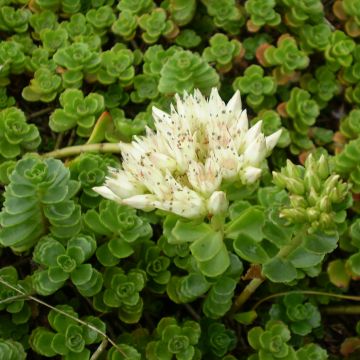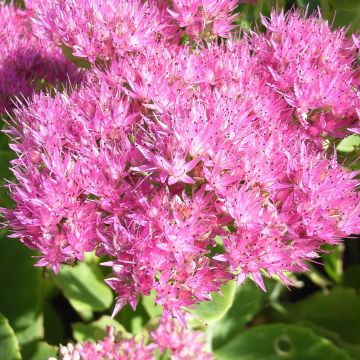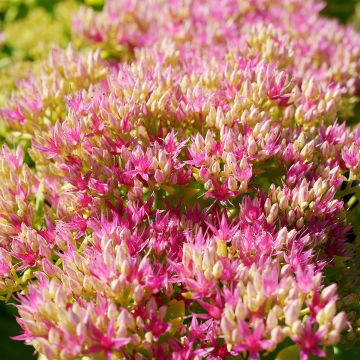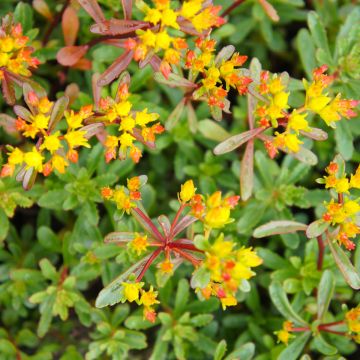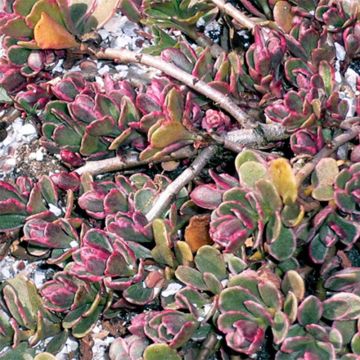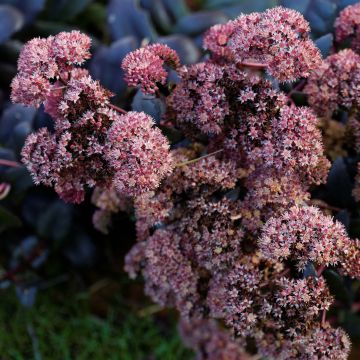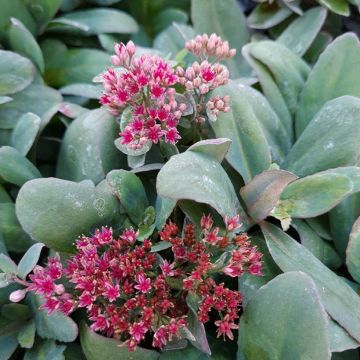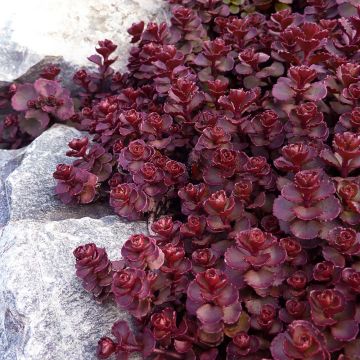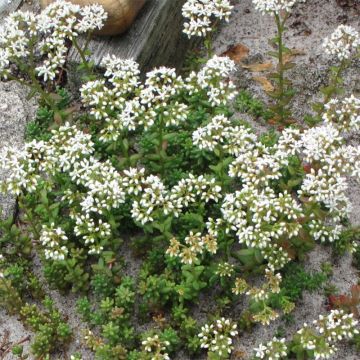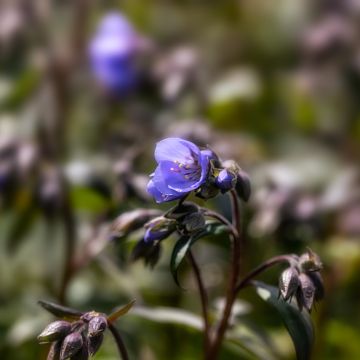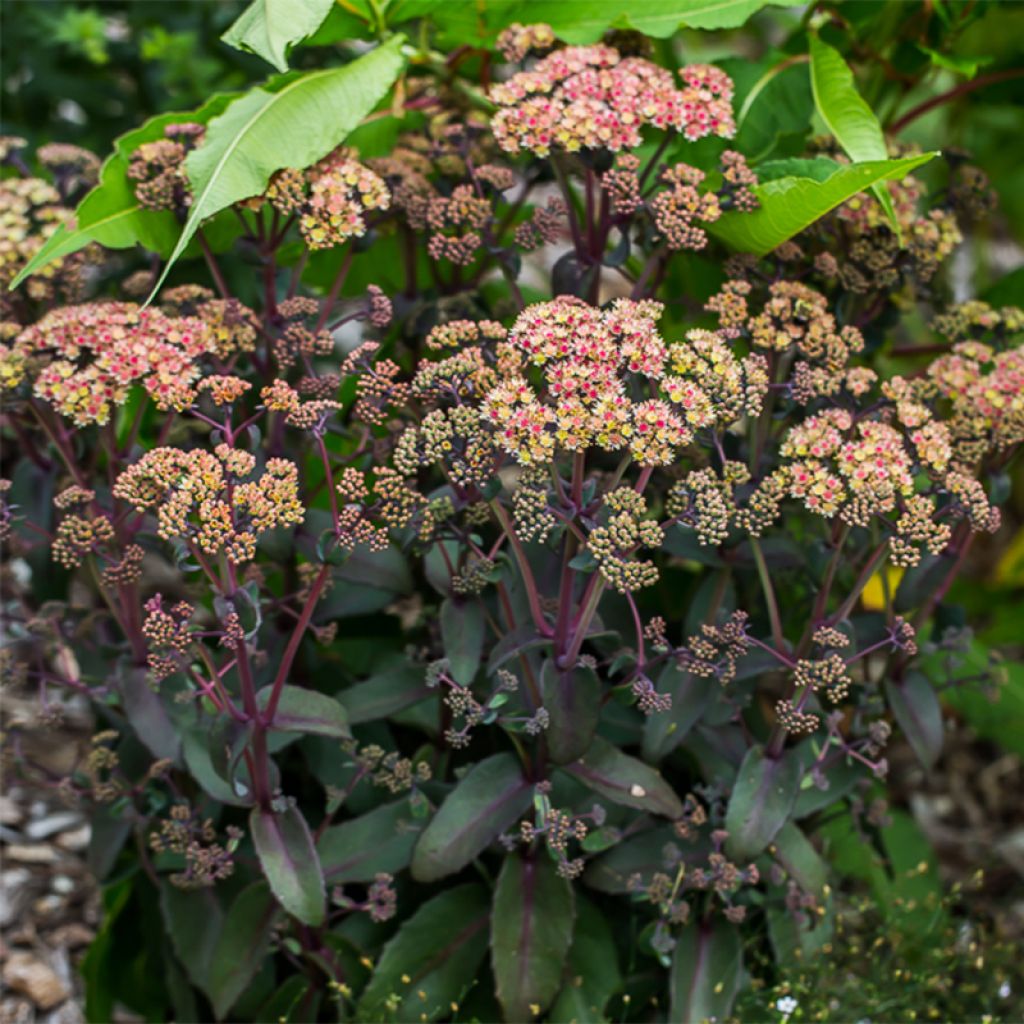

Sedum spectabile Orange Xenox - Autumn Stonecrop
Sedum spectabile Orange Xenox - Autumn Stonecrop
Sedum x spectabile Orange Xenox
Autumn Stonecrop
Perfect. After the first year with flowers on all three plants received, new shoots are appearing again this year.
Boris, 28/02/2024
Why not try an alternative variety in stock?
View all →This plant carries a 12 months recovery warranty
More information
We guarantee the quality of our plants for a full growing cycle, and will replace at our expense any plant that fails to recover under normal climatic and planting conditions.
From €5.90 for pickup delivery and €6.90 for home delivery
Express home delivery from €8.90.

Does this plant fit my garden?
Set up your Plantfit profile →
Description
Sedum 'Orange Xenox' is a recent variety of autumn stonecrop, which will seduce you with its compact and bushy habit that holds excellently, as well as with the magnificent colours of its dark purple-grey foliage, topped with barely rounded, pinkish-purple inflorescences tinged with orange, animated by a constant ballet of butterflies. The whole plant, somewhat nostalgic but full of resources, harmonises perfectly with the somewhat languid atmosphere that characterises our late season. This undemanding variety is a carefree plant, adapted to mediocre soils.
Sedums belong to the Crassulaceae family. 'Orange Xenox', obtained in 2012 in the Netherlands, is one of the many cultivars derived from Sedum spectabile, native to China and Korea. It forms compact, upright tufts, reaching 40 to 45 cm (16 to 18 in) in height and spreading over 30 cm (12 in), with fairly slow growth. Flowering occurs as early as September and continues until the first frost. The inflorescences, in flat and dense terminal cymes, reach 12 cm (5 in) in diameter. The tiny flowers begin as salmon-pink buds, then bloom in pinkish-purple and finally in orange. Intensely nectariferous and honey-producing, they attract many butterflies and bees. The robust herbaceous stems, purple in colour, emerge from the basal foliage composed of leaves 6 cm (2 in) long and 4 cm (2 in) wide; it is fleshy, embossed, purple-grey to brown in colour, and as decorative as the flowering. The leaves are flat and ovate, toothed on the upper half. This completely deciduous plant disappears in late autumn and resurfaces from the ground in spring.
A godsend for gardens where the soil lacks thickness, Sedum spectabile is above all a drought-tolerant plant. Pair it with grasses such as Stipa, Muhlenbergia, Panicum, certain carex and other grey-leaved plants that often similarly tolerate these difficult growing conditions. You will create an unforgettable scene by associating it with autumn asters (Le Vasterival, Calliope, A. turbinellus) or Magellan fuchsias. Magnificent in its pot form, it is also an excellent flower for drying or for bouquets.
Report an error about the product description
Sedum spectabile Orange Xenox - Autumn Stonecrop in pictures
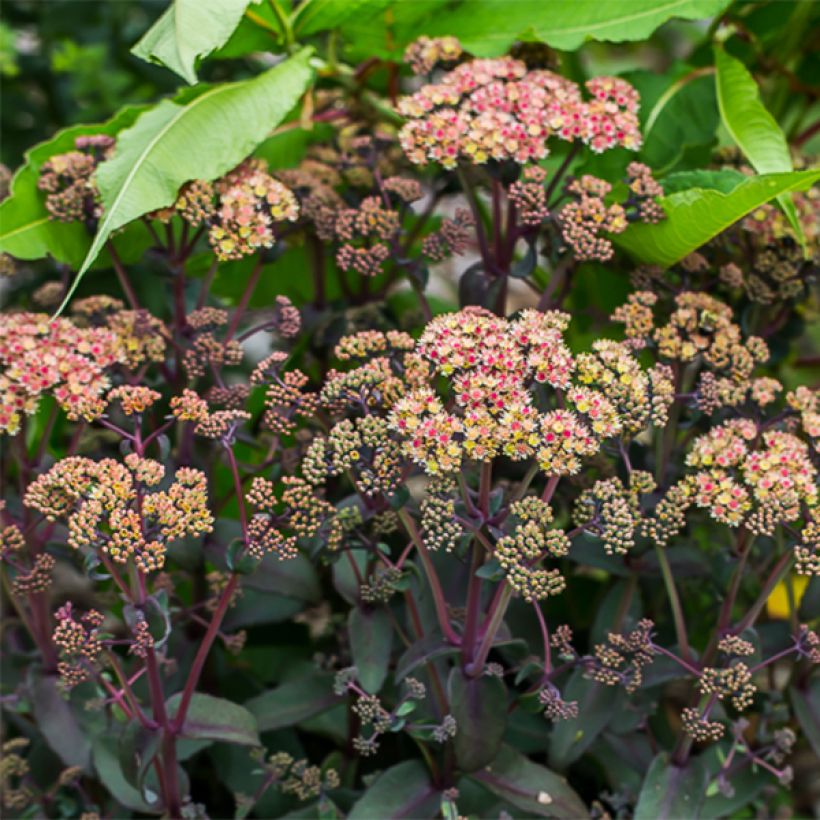

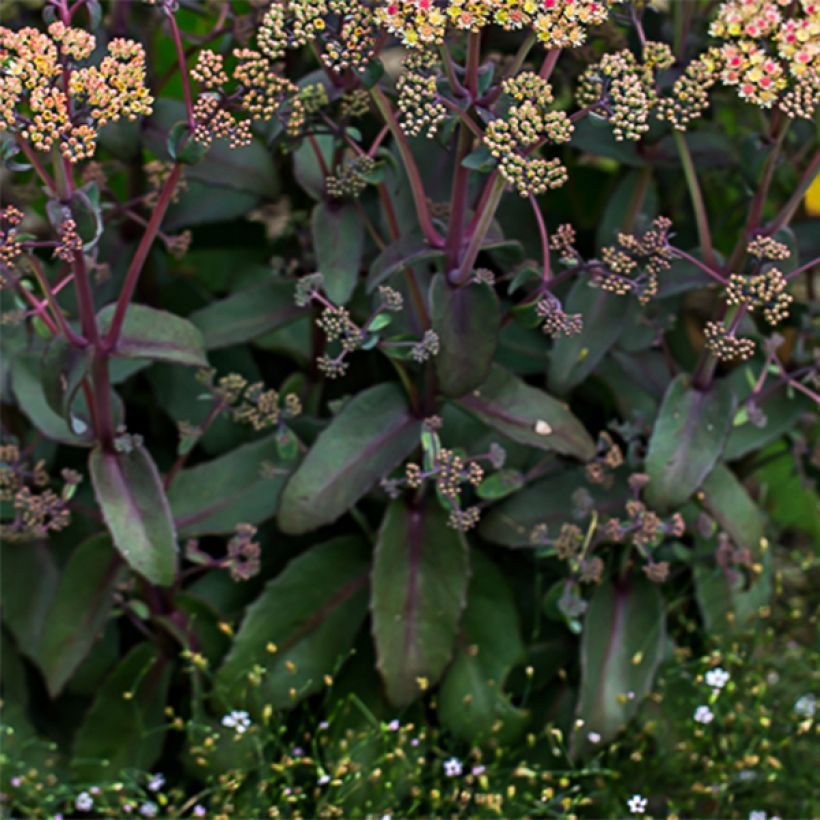

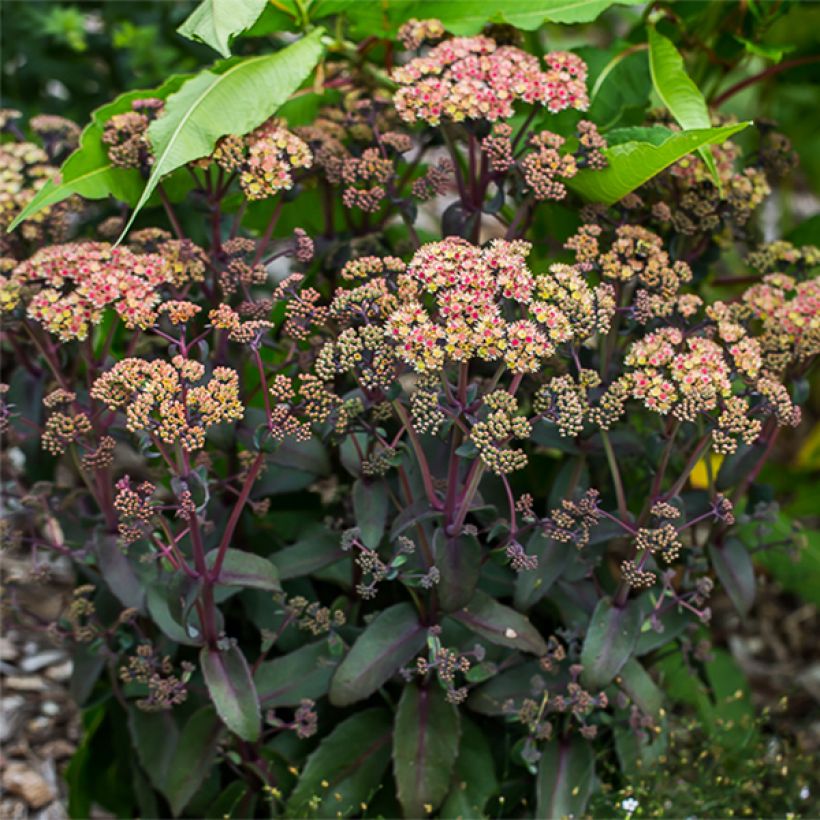

Flowering
Foliage
Plant habit
Botanical data
Sedum
x spectabile
Orange Xenox
Crassulaceae
Autumn Stonecrop
Cultivar or hybrid
Other Sedum
Planting and care
Plant Sedum Orange Xenox in ordinary soil that is more or less rich, or even dry, sandy and calcareous, but that must be well drained to protect the roots from the cold moisture of winter. It tolerates clay soils in regions with dry winters. Excessive fertiliser can deform this well-branched variety. Plant it in full sun to enhance the colour of its foliage. This plant is hardy once established. It needs a certain amount of coolness during its growing period. In pots, provide a layer of gravel for drainage. Cut back the clump in winter when it is dry. Divide the plant after 3 to 4 years in order to encourage vigorous growth and prevent it from thinning out in the centre as well as the lateral stems collapsing onto the ground. Stonecrops are very easy to propagate. In spring, cut a stem or even a leaf that you then leave to dry for a few days in the shade, before placing them in a tray of moist sand.
Planting period
Intended location
Care
-
, onOrder confirmed
Reply from on Promesse de fleurs
Coloured foliage perennials
Haven't found what you were looking for?
Hardiness is the lowest winter temperature a plant can endure without suffering serious damage or even dying. However, hardiness is affected by location (a sheltered area, such as a patio), protection (winter cover) and soil type (hardiness is improved by well-drained soil).

Photo Sharing Terms & Conditions
In order to encourage gardeners to interact and share their experiences, Promesse de fleurs offers various media enabling content to be uploaded onto its Site - in particular via the ‘Photo sharing’ module.
The User agrees to refrain from:
- Posting any content that is illegal, prejudicial, insulting, racist, inciteful to hatred, revisionist, contrary to public decency, that infringes on privacy or on the privacy rights of third parties, in particular the publicity rights of persons and goods, intellectual property rights, or the right to privacy.
- Submitting content on behalf of a third party;
- Impersonate the identity of a third party and/or publish any personal information about a third party;
In general, the User undertakes to refrain from any unethical behaviour.
All Content (in particular text, comments, files, images, photos, videos, creative works, etc.), which may be subject to property or intellectual property rights, image or other private rights, shall remain the property of the User, subject to the limited rights granted by the terms of the licence granted by Promesse de fleurs as stated below. Users are at liberty to publish or not to publish such Content on the Site, notably via the ‘Photo Sharing’ facility, and accept that this Content shall be made public and freely accessible, notably on the Internet.
Users further acknowledge, undertake to have ,and guarantee that they hold all necessary rights and permissions to publish such material on the Site, in particular with regard to the legislation in force pertaining to any privacy, property, intellectual property, image, or contractual rights, or rights of any other nature. By publishing such Content on the Site, Users acknowledge accepting full liability as publishers of the Content within the meaning of the law, and grant Promesse de fleurs, free of charge, an inclusive, worldwide licence for the said Content for the entire duration of its publication, including all reproduction, representation, up/downloading, displaying, performing, transmission, and storage rights.
Users also grant permission for their name to be linked to the Content and accept that this link may not always be made available.
By engaging in posting material, Users consent to their Content becoming automatically accessible on the Internet, in particular on other sites and/or blogs and/or web pages of the Promesse de fleurs site, including in particular social pages and the Promesse de fleurs catalogue.
Users may secure the removal of entrusted content free of charge by issuing a simple request via our contact form.
The flowering period indicated on our website applies to countries and regions located in USDA zone 8 (France, the United Kingdom, Ireland, the Netherlands, etc.)
It will vary according to where you live:
- In zones 9 to 10 (Italy, Spain, Greece, etc.), flowering will occur about 2 to 4 weeks earlier.
- In zones 6 to 7 (Germany, Poland, Slovenia, and lower mountainous regions), flowering will be delayed by 2 to 3 weeks.
- In zone 5 (Central Europe, Scandinavia), blooming will be delayed by 3 to 5 weeks.
In temperate climates, pruning of spring-flowering shrubs (forsythia, spireas, etc.) should be done just after flowering.
Pruning of summer-flowering shrubs (Indian Lilac, Perovskia, etc.) can be done in winter or spring.
In cold regions as well as with frost-sensitive plants, avoid pruning too early when severe frosts may still occur.
The planting period indicated on our website applies to countries and regions located in USDA zone 8 (France, United Kingdom, Ireland, Netherlands).
It will vary according to where you live:
- In Mediterranean zones (Marseille, Madrid, Milan, etc.), autumn and winter are the best planting periods.
- In continental zones (Strasbourg, Munich, Vienna, etc.), delay planting by 2 to 3 weeks in spring and bring it forward by 2 to 4 weeks in autumn.
- In mountainous regions (the Alps, Pyrenees, Carpathians, etc.), it is best to plant in late spring (May-June) or late summer (August-September).
The harvesting period indicated on our website applies to countries and regions in USDA zone 8 (France, England, Ireland, the Netherlands).
In colder areas (Scandinavia, Poland, Austria...) fruit and vegetable harvests are likely to be delayed by 3-4 weeks.
In warmer areas (Italy, Spain, Greece, etc.), harvesting will probably take place earlier, depending on weather conditions.
The sowing periods indicated on our website apply to countries and regions within USDA Zone 8 (France, UK, Ireland, Netherlands).
In colder areas (Scandinavia, Poland, Austria...), delay any outdoor sowing by 3-4 weeks, or sow under glass.
In warmer climes (Italy, Spain, Greece, etc.), bring outdoor sowing forward by a few weeks.


































